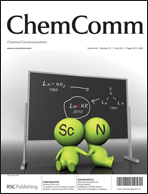Synthesis and stabilization—advances in organoalkaline earth metal chemistry
Abstract
The last decade has seen an impressive growth in alkaline earth metal chemistry, with applications ranging from synthetic organic and polymer chemistry to materials science. As a consequence, alkaline earth metal chemistry has made a leap from obscurity into the spotlight of modern organometallic chemistry. Much of this rapid development was made possible by the establishment of novel synthetic procedures that allowed facile access to the target compounds, as many conventional synthetic routes posed and continue to pose significant limitations. Novel approaches have allowed the preparation of a multitude of compounds, initiating progress not thought possible just five years ago. Examination of the new compounds delineates several factors responsible for their structure and function. Key elements in the coordination, aggregation behavior, and reactivity of these systems have been linked to secondary interactions, including M–Cπ, M–Nπ, M–F, and M–H(agostic) interactions. This feature article will provide a very brief overview of established synthetic procedures, including a brief discussion on specific shortcomings. This will be followed by a detailed presentation of novel methodologies that are the core of the rapid development of alkaline earth metal chemistry. The second part of the article will be concerned with the analysis of various secondary interactions and their role in the further development of this rapidly emerging field of chemistry.


 Please wait while we load your content...
Please wait while we load your content...